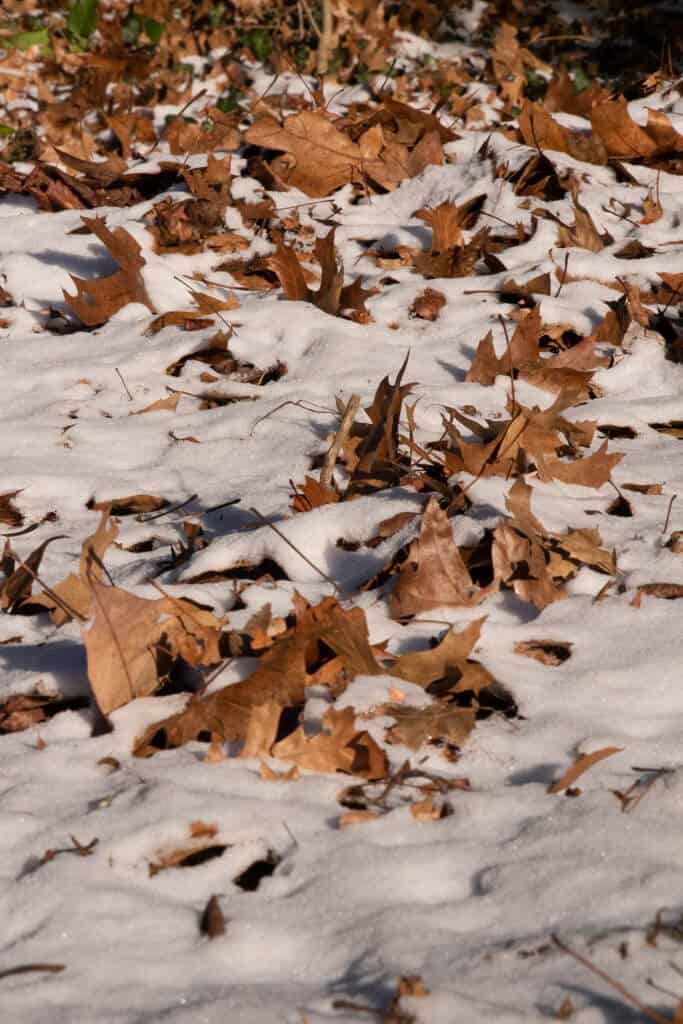Winter Composting Tips: Keep Your Heap Hot as Temperatures Drop
Winter composting tips for maintaining your compost pile all year long.
Composting during winter may seem challenging due to the cold temperatures, but with the right strategy, it’s completely feasible. Maintaining a healthy compost pile in colder weather is all about balance and understanding how the colder climate affects decomposition. Keeping your compost active during winter prevents a lull in the composting process, which means that come spring, you’ll be rewarded with rich, nutritious material ready for your garden. Of course, winter composting won’t work as fast as in the other seasons, but it is still worth maintaining!

One of the key considerations is the location of the compost pile. If it’s exposed to the elements, it might freeze solid, halting the composting process. Therefore, I always suggest placing it in a spot that receives some winter sun but is shielded from harsh winds. Ensuring good insulation is another crucial element. I personally use a compost tumbler in winter to avoid freezing and maintain heat, but you can layer an in-ground compost pile with straw or leaves to retain heat, helping the microorganisms within to stay active and break down materials effectively.
A healthy compost pile needs the right mix of browns and green. In winter, I tend to add more brown matter, like sawdust and shredded paper, to absorb excess moisture and maintain airflow. This helps prevent the pile from becoming too wet and compacted under snow or rainfall. I also advise you to keep adding kitchen food scraps throughout the winter, burying them deep within the pile to provide a continual source of nitrogen and to keep the composting process going, even when the thermometer dips.
Understanding Winter Composting
Winter composting is a unique process that requires special attention due to the cold weather. I’ll share insights to help you maintain an active compost pile even when temperatures drop.
Fundamentals of Winter Composting
During the colder months, the main goal is to keep the composting process active despite the drop in temperature.
- Microbial Activity: Cold weather slows down microbial activity. To counter this, balance greens (nitrogen-rich materials) and browns (carbon-rich materials) to keep the microorganisms fed and working.

Tip: A larger pile retains heat better. Aim for at least one cubic yard to maintain internal heat.
Challenges and Benefits of Winter Composting
Challenges:
- Monitoring Moisture: Check the moisture levels of your compost pile more frequently in winter. It should be moist like a wrung-out sponge to promote decomposition.
- Slow Decomposition: Be aware that the composting process will inevitably slow down in cold temperatures, and adjust your expectations accordingly.
Benefits:
- Less Smell: The cold months typically mean less odor since the cold temperatures slow down decomposition, resulting in minimal smell from the compost pile. Please note: a really healthy compost pile should not smell bad, no matter the time of year (but we can’t always be perfect!).
- Spring Preparation: By maintaining compost in winter, you can ensure you have a rich supply of compost ready for your garden in spring.
By understanding these fundamentals and balancing the challenges with the benefits, I can keep my composting efforts productive throughout the winter months.

Essential Components for Winter Composting
In winter composting, I focus on maintaining the right balance and preserving the composting activity in my pile even as the temperatures drop. Get this free printable to help remember common greens and browns for your at-home compost.
Managing Moisture and Aeration
Moisture: Maintaining the right moisture levels is important. Aim for consistency like a wrung-out sponge. If the pile gets too wet from rain or snow, add more brown materials to absorb excess moisture.
Aeration: Even in winter, oxygen is vital. Turn the pile occasionally to introduce air. This promotes the breakdown of organic matter and prevents the pile from becoming compacted, which can slow down the composting process.
By managing these components and paying attention to the condition of my compost pile, I find that even during the coldest months, I can successfully transform kitchen scraps and yard waste into valuable compost for my garden.
Best Practices for Cold-Climate Composting
The right balance of materials and offer some insulation to encourage microbial activity. Here’s how I manage it:
Maintaining Compost Pile Active
To keep a compost pile bustling through the cold, focus on mix, insulation, and aeration.
- Insulation: Burlap sacks, old blankets
- Aeration: Turn weekly
- Tools: Compost tumbler or rake to turn your pile
A compost tumbler is also invaluable during winter for its ability to maintain higher temperatures internally. I make sure to turn my compost weekly to introduce air and distribute the heat evenly — this tactic is vital for sustaining microbial activity, even when it’s freezing outside.

Maximizing Heat Retention
In colder climates, retaining heat in your compost pile is essential to keep the decomposition process active through the winter. Let me show you two effective ways to achieve this.
Insulating Your Compost Bin
To prevent heat loss in colder temperatures, proper insulation around your compost bin is crucial. One effective method is wrapping your bin with burlap bags stuffed with straw or hay. Alternatively, if your bin is situated on the ground, piling hay bales or straw bales around the perimeter can serve as an excellent insulation barrier. For increased insulation in the coldest weather, consider placing bags of leaves around and on top of the compost bin. Make sure the lid or cover is also insulated to prevent heat from escaping upward.
- Materials for Insulation:
- Burlap bags stuffed with straw or hay
- Hay bales or straw bales
- Bags of leaves

Turning and Aeration Techniques
Regular turning and aeration help distribute heat evenly throughout the compost and promote microbial activity. Even in a cold climate, I recommend turning your compost pile every couple of weeks. However, be careful not to overdo it, as excessive turning can lead to more heat loss. Use a garden fork or a compost turner to gently mix the pile. My aim is to bring the colder, outer layers to the inside, where they can warm up, and push the already warm, inner material out to the edges.
- Aeration Tools:
- Garden fork
- Compost turner
Remember, strategic turning in combination with robust insulation is key to maintaining an active compost pile in winter.
Optimizing the Compost Mix
An optimal mix of greens and browns is crucial for a healthy compost pile. In winter, I make sure my balance leans towards more browns, as they’re drier and help absorb excess moisture from food waste. I also chop my kitchen scraps and yard waste into smaller pieces; this increases the surface area for microbes to work on and helps keep my compost active.
Microbial Activity: Cold weather slows down microbial activity. To counter this, balance greens (nitrogen-rich materials) and browns (carbon-rich materials) to keep the microorganisms fed and working.
Here’s the balance I strive for:
Balancing Browns and Greens
Browns (carbon-rich materials):
- Dry leaves
- Straw
- Shredded paper
Greens (nitrogen-rich materials):
- Kitchen scraps (vegetable peels, fruit waste, coffee grounds)
- Fresh grass clippings
- Garden waste (plant trimmings)

To ensure compost remains active during winter, maintain a ratio of about 3 parts brown to 1 part green materials. This balance encourages microbial activity and heat generation, which are crucial for the composting process.
By sticking to these practices, I ensure that my compost remains a nutrient-rich haven for my garden, even in the coldest months!
Utilizing Winter Compost Outputs
I don’t really harvest my compost during the winter, but if you plan to harvest yours for seed starting, you can use the following tips!
Harvesting ‘Black Gold’
The center of your compost pile becomes a treasure trove, brimming with ‘black gold.’ This nutrient-rich compost forms despite the chilly weather, as long as the compost pile stays active. To collect this ‘black gold,’ follow a few simple steps:
- Locate the Warm Center: Diig into the pile until you reach the warmer, decomposed center.
- Sift the Compost: Use a mesh screen to sift the finished compost, separating any large, undecomposed pieces.
- Store Properly: Store the sifted compost in a dry, covered container to maintain its quality.
Check out this post for tips on how to know when your compost is ready!
Prepping for the Growing Season
Once you’ve harvested the ‘black gold,’ take certain actions to ensure the garden beds are primed for planting season:
- Enrich the Soil: Mix the finished compost into your garden beds to enrich the soil with nutrients, bolstering it for the growing season.
- Dream big, order your seeds, and plan your garden for the season ahead!
By following these steps, I make the most out of my winter compost, setting a solid foundation for a flourishing garden when spring arrives. It’s a good idea to keep those winter compost piles cookin’, not only for your garden but for reducing your kitchen waste as well.

Cole weather got you down? Start a Worm Bin! If it’s excessively cold outside and you don’t want to deal with your pile, you can maintain a worm bin indoors (vermiculture), where they help break down kitchen scraps into quality compost.
FAQ about Winter Composting
Can I compost in extremely cold climates?
Yes, you can compost in extremely cold climates, but it may require additional insulation and protection for the compost pile. Using well-insulated bins, incorporating more browns for insulation, and covering the pile can help maintain composting activity. If it is seriously cold, you don’t have to stress! Let it freeze and catch back up with it in the spring. You can always freeze your food scraps to add later if you want to be sustainable.
What types of composting bins or systems are best for winter?
Compost tumblers are effective for winter composting as they help retain heat internally. Additionally, well-insulated bins or compost piles surrounded by materials like straw or leaves can work well in colder climates.
How do I deal with pests in winter compost piles?
To manage pests, bury kitchen waste deep within the compost pile, and consider using pest-resistant compost bins or covering the pile with a secure lid.
Is it possible to compost in an apartment or with limited outdoor space in winter?
Yes, it’s possible. Indoor composting methods, such as vermicomposting (using worms) or bokashi composting, are suitable for apartments. These methods allow composting without relying on outdoor conditions, no matter the season!
What materials should be avoided in winter composting?
Materials to avoid in winter include large chunks of woody material that might not break down easily in the cold, and excessive amounts of citrus peels or acidic materials, which can slow down the decomposition process.
How do I troubleshoot a frozen compost pile?
If your compost pile is frozen, avoid turning it, as this may cause more heat loss. Instead, focus on adding more insulating materials like straw, leaves, or shredded newspaper. Wait for a thaw, and then resume turning and aerating.
How can I tell if my compost pile is active during winter?
Signs of an active compost pile in winter include a slight warmth when you insert your hand into the center, ongoing microbial activity (visible decomposition), and the absence of foul odors. Monitoring moisture levels and observing a balanced mix of browns and greens also indicate activity.
Pin it for later!

Free Compost List Printable

About the Author:
I’m Brittany, totally modern and mainstream turned crunchy mama!
Read more here about how I went from a totally incompetent cook and hyper-consumer to striving to live a more meaningful life from scratch.
I can’t wait to share my modern homesteading journey with you and I hope I inspire you to join along!






